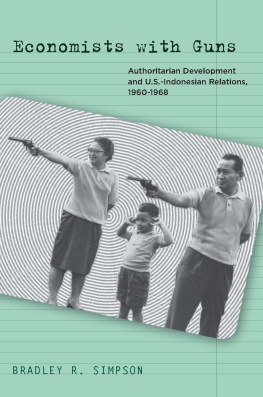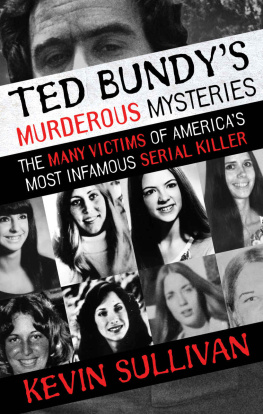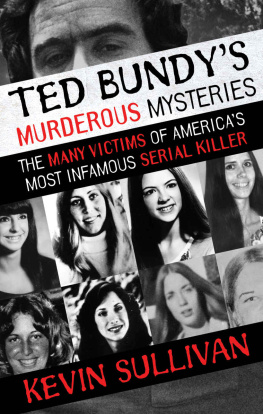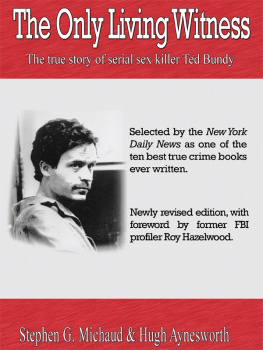Introduction

Ted Bundy (1946-1989)
"I'm the most cold-hearted son of a bitch you'll ever meet. Ted Bundy
I don't think anybody doubts whether I've done some bad things. The question is: what, of course, and how and, maybe even most importantly, why? Ted Bundy
For most people, Ted Bundy is the quintessential serial killer - a good-looking, highly intelligent man who used his charm to lure an untold number of women to their deaths. In fact, as the judge announced his death sentence, he noted Bundys intellect and mused that he would have enjoyed hearing Bundy try a case before him had he remained simply the genius law student he had once been.
Bundy, of course, ended up choosing a far different path, going on a historic crime spree during the 1970s so prolific that estimates of his kill count vary by dozens, a debate Bundy was only too happy to stoke. On one occasion, when the FBI estimated he was responsible for 3 dozen murders, Bundy replied, "Add one digit to that, and you'll have it." On another occasion, he claimed the estimate of 3 dozen was close to accurate.
Whatever the actual number, what is known is that the murders ranged from coldly calculated approaches of women in public places to breaking into homes at night and bludgeoning victims to death. Bundy often kept mementoes to commemorate the crimes, ranging from victims possessions to their severed heads.
As is natural in cases like this, attempts to understand Bundys pathology have been ongoing for decades, with separate diagnoses of narcissistic personality disorder and bipolar disorder, and one prison official described Bundys changing personalities: He became weird on meAlmost a complete change of personality ... that was the day I was afraid of him.
Unfortunately, Bundy proved resourceful in other ways aside from committing murder. After he was initially caught in Utah in 1975 and being tried for attempted assault, murder charges were brought against him in Colorado, but Bundy escaped prison twice in succession, allowing him to commit an untold number of additional crimes until he was caught again in Florida in 1978.
Shortly before his death, in an interview with the popular Christian psychologist Dr. James Dobson, Bundy blamed his problems on pornography and claimed to have found God and repented, yet he had noted in a letter in 1977 that he almost never looked at porn magazines, telling future biographer Ann Rule, Who in the world reads these publications? ... I have never purchased such a magazine, and [on only] two or three occasions have I ever picked one up." . Regardless of his motives, after nearly a decade of denials, Bundy confessed to having killed at least 30 women across 7 states in just a 5 year period the decade before. In her work on the serial killer, Ann Rule labeled him a sadistic sociopath who took pleasure from another human's pain and the control he had over his victims, to the point of death, and even after." Even a member of his own defense team, Polly Nelson, called him the very definition of heartless evil.
Ted Bundy: The Life and Crimes of One of Americas Most Notorious Serial Killers looks at the life of the serial killer and the crimes he committed. Along with pictures of important people, places, and events, you will learn about Ted Bundy like never before, in no time at all.
Chapter 1: The First Time
No one knows when or where Theodore Ted Bundy killed for the first time. It could have been during his teenage years or when he was in his early 20s in the late 1960s. It might have been in Washington State, where he resided for many years, or on the East Coast, where he was born and lived as a young boy and had family ties. But we do know that by 1974, Ted Bundys prolific reign of terror and murder was underway. In Washington State, young, attractive female college students began disappearing. Local police investigated, and clues began to emerge. Witnesses pointed to a Volkswagen Beetle and a young man on crutches or with an arm in a sling. Bundy moved to Salt Lake City that summer, and the murders continued in Utah, Idaho, and Colorado. In August 1975, police arrested Bundy for the first time after pulling him over in his Volkswagen and finding suspicious itemsincluding handcuffs, rope, and a ski maskthat investigators later linked to missing women. In February of the following year, he was found guilty of kidnapping and assaulting a Utah teenager who had managed to escape from him, landing in prison for up to 15 years. Meanwhile, investigators from multiple states were piecing together the string of murders. In 1976, Bundy was charged with killing a vacationing nursing student, and he found himself in Aspen, Colorado in June 1977 for a preliminary hearing. Left alone at one point, Bundy let himself out of a second story window, jogged down Main Street, and disappeared. The FBI summary of the Bundy Case
It is unlikely that anyone is born a serial killer. In fact, the very idea that a young child can already have in his heart the desire to kill is repugnant to human nature. However, there were certainly red flags from early in the life of Theodore Robert Cowell, who was born on November 2, 1946 at the Elizabeth Lund Home for Unwed Mothers in Burlington, Vermont. His mother, Louise, listed a man named Lloyd Marshall as his father but later said that the real father was someone else. After she recovered from the birth, Louises parents, Samuel and Eleanor, brought her and her son back to their home in Philadelphia, where they raised the boy as their own for the first three years of his life. Young Ted idolized the man he believed to be his father, though Samuel himself was said to have been a cruel and possibly even schizophrenic individual known to abuse animals and people alike. Eleanor also showed signs of mental illness, including depression, anxiety, and agoraphobia; she was treated periodically with electroconvulsive therapy.
Tragically for the family and dozens of others, young Ted seemed to have inherited all the markers for his grandparents illnesses but none of the societal constraints that kept the elder Cowells in check. His aunt Julia later relayed a story about waking up to find that the three year old boy had surrounded her bed with knives. The question, of course, is whether this event was really as sinister at the time as it later appeared in retrospect, given that toddlers do all sorts of odd things without later becoming serial killers.
Not long after this incident, Louise suddenly decided to take her son and move across the country to Tacoma, Washington. There she called herself Louise Nelson, lived with her cousins, Alan and Jane Scott, and attended the First Methodist Church. It was at one of their singles nights that she met Johnny Bundy, a cook at the local hospital. After the two married in 1952, Bundy adopted Ted and gave him his last name. In his now famous interview with James Dobson, Bundy recalled, I grew up in a wonderful home with two dedicated and loving parents, as one of five brothers and sisters. A home where we, as children, were the focus of my parents lives. We regularly attended church. Two Christian parents, they did not drink, they did not smoke, there was no gambling, there was no physical abuse or fighting in the home. Im not saying this was Leave it to Beaverbut it was a fine, solid Christian home. And nobody, I hope no one will try to take the easy way out, and try to blame or otherwise accuse my family of contributing to this because, I know, and Im trying to tell you as honestly as I know how, what happened.




















